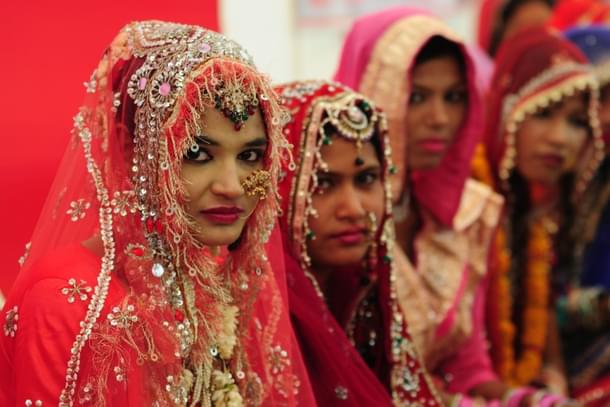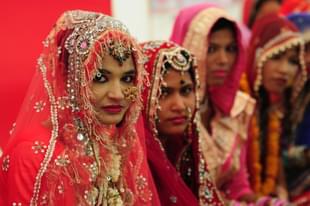Ideas
Why Increasing Women’s Age Of Marriage To 21 Is An Unnecessary Gimmick; Government Should Rather Focus On Fixing The Basics
Arihant Pawariya
Aug 21, 2020, 05:56 PM | Updated 06:01 PM IST
Save & read from anywhere!
Bookmark stories for easy access on any device or the Swarajya app.


Famous British TV Comedy show Yes, Minister introduces us to two afflictions that politicians suffer from.
One, the overwhelming desire to do something, mistaking activity for accomplishment. I call it the “Politician’s Burden".
Second, they resort to the “Politician’s Syllogism”. It goes like this:
Premise 1: We must do something.
Premise 2: This is something.
Conclusion: Therefore, we must do this.
Here is another example from the show:
Premise 1: All cats have four legs.
Premise 2: My dog has four legs.
Conclusion: Therefore, my dog is a cat.
The fallacies in the above examples would be apparent to anyone without any introduction to formal logic.
In India, the Union government seems intent on “doing something” about the legal minimum age of marriage.
It’s totally unnecessary. But the leaders in the government seem afflicted with the ailment of the “politician’s burden”. Moreover, the government as well as its supporters are also using “politician’s syllogism” to further their justification for doing something.
So, I thought it would be fun to test their arguments using formal logic.
On 4 June, via a gazette notification, the government set up a task force to examine matters pertaining to the age of motherhood, imperatives of lowering maternal mortality rate (MMR), improvement of nutritional levels, etc.
Following are the four main terms of reference of the task force:
- To examine the correlation of age of marriage and motherhood with (a) health, medical well-being and nutritional status of mother and neonate/infant/child, during pregnancy, birth and thereafter, (b) key parameters like infant mortality rate (IMR), MMR, total fertility rate (TFR), sex ratio at birth (SRB), child sex ratio (CSR) etc, and (c) any other relevant points pertaining to health and nutrition in this context.
- To suggest measures for promoting higher education among women.
- To suggest suitable legislative instruments and/or amendments in existing laws to support the recommendations of the task force.
- To work out a detailed roll-out plan with timelines to implement the recommendations of the task force.
The Union Ministry of Health has also shared its views on the matter. It tweeted the following in response to fake news story run by a digital media outlet.

This basically covers the main arguments given in favour of raising the minimum legal age for marriage. Before we analyse these “arguments” using formal logic, let us go back to the first and main term of reference of the task force.
It will examine the correlation of age of marriage and motherhood with (a) health, medical well-being and nutritional status of mother and neonate/infant/child, during pregnancy, birth and thereafter, (b) key parameters like IMR, MMR, TFR, SRB, CSR etc, and (c) any other relevant points pertaining to health and nutrition in this context.
First, there is enough research out there already which proves that the age of motherhood is related to health/well-being/nutritional status of mother, infant child, the child’s later development. If the pregnancies are in teenage, then all these factors will be negatively impacted. So, delaying the age of marriage will have a positive impact on all these indicators.
Second, parameters like IMR, MMR, TFR, SRB, CSR are also linked to age of motherhood, even though not exclusively.
For instance, a woman (from rich background, endowed with good health) delivering a baby at 20 years of age is likely to be less worse off than a poor woman with not so good health. But in a country like India, unlike earlier when everyone married off their daughters early, age of motherhood is intricately linked to poverty and all the baggage that come with it, including poor health.
So, in general, for all practical purposes, we can assume that delaying motherhood would positively impact IMR, MMR, SRB, SCR but negatively impact TFR (studies have shown that delaying motherhood by a few years lead to reduction in number of babies a women would have over the period of her fertile life).
Overall, one can say that, delaying motherhood by a few years may not be a bad idea and will be beneficial to most of the women, especially the poor sections of the society.
Now, let’s summarise the arguments in favour of increasing the minimum legal age for marriage and analyse their soundness using logic.
Premise 1: Delaying motherhood will positively impact health indicators of women and her progeny.
Premise 2: Delaying motherhood could open possibilities of higher education for women.
For the sake of probity, I am only entertaining sound arguments where premises are true. (This is why I use the word "could” rather than "would” because using the latter would make the Premise 2 false — for access to higher education depends on many other factors and not marrying/bearing child early can be only one of the obstacles.)
Now, from the above two premises, the government as well as its supporters have drawn many conclusions. These are:
Higher threshold marriage age would lead to:
Conclusion 1: access to education.
Conclusion 2: more freedom in marital choices.
Conclusion 3: more economic independence.
Conclusion 4: more reproductive freedom.
Conclusion 5: better chances of joining the work force.
Of course, all of these conclusions are false. Because none of the conclusions can be deducted from the given premises.
In fact, all the conclusions are basically benefits of improving access of education to women and not that of increasing minimum legal age of marriage for them. Educating women would certainly lead to more prosperity, improve their freedom in marital choices, give them more economic independence, more reproductive freedom and increase their chances of joining the work force.
But it’s patently wrong to infer that simply delaying the marriageable age will lead to access to higher education and this in turn makes all the conclusions false.
This leaves out one more form of argument furthered by advocates of increasing the legal age of marriage to 21:
Premise:1: Delaying motherhood will positively impact health indicators of women and her progeny.
Premise 2: Increasing legal age of marriage to 21 will ensure that parents who would’ve married their daughter at 18 would now marry them off at 21.
Conclusion: Therefore, to achieve better health indicators, the legal age of marriage should be increased.
This argument is not sound because Premise 2 is false. Hence, conclusion drawn is wrong.
Past record of 42 years (since the legal age of marriage was set at 18 for women and 21 for men) shows that it’s not the law which has decreased the rate of child marriages but access to education, job opportunities and economic prosperity.
The government would do well to focus on these three things rather than trying to shrug of responsibility of hard work by taking a shortcut of passing a law.
Average age of first pregnancy in India has already increased to more than 22 years. So, changing law would be just a gimmick trying to address the problem which doesn’t really exist.
Therefore, those critics who think this change will drastically reduce TFR of Hindu women or those supporters who think this law will do wonders for women are both highly overestimating its impact. It will do neither and will be a dud on arrival.
Arihant Pawariya is Senior Editor, Swarajya.





